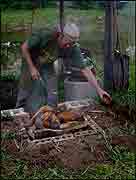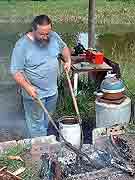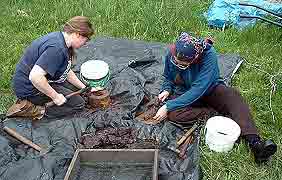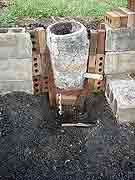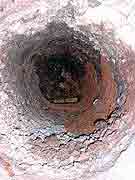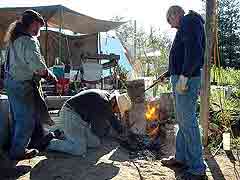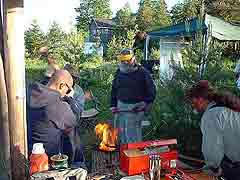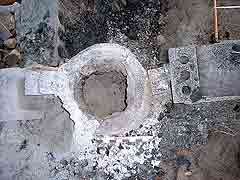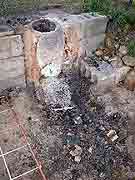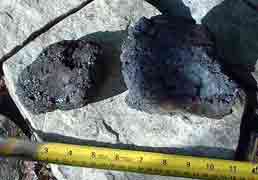"Hot Swap" - Double Smelt
Experiments 23 & 24 - D11 & D12
Date: June 9, 2007
Location : Wareham
Team One : , Neil Peterson (smelt master), Darrell Markewitz, Dr Ron Ross
Team Two: Dave Cox (smelt master), Kevin Jarbeau, Ken Cook
Record Keeper: Sam Falzone
Smelter Type: Norse Short Stack
Wall Material : Clay Cobb - smelter half dug into bank
Air Supply: Standard vacuum blower
Interior Diameter: 9"
Stack above tuyere: 16"
(Metal collar adds another 12" extra stack above tuyere)
Tuyere above base: 5.5"
Tuyere Angle: 15 degrees down angle
Tuyere penetration at start: 3/4"
Note: This is the fourth and fifth firing of this smelter, the third and fourth
use of the same tuyere tube.
The objectives for this experiment were the following:
1) Re-use of existing smelter
The current clay cobb furnace was fired three times in 2006. With some minor
patching the furnace will easily be able to withstand another sequence. We hope
to match this furnace to the sequence of patching and re-use seen on excavated
furnaces. Objective two relates to this process as well.
2) 'Hot Swap' - a double bloom firing
In the past we have seen that a large part of the charcoal consumed is used
to bring the furnace structure up to operation temperature and to create the
underlying slag bowl. If manpower permits, we intend to extract the first bloom,
then immediately re-fill the furnace and start straight into a second smelt
sequence. A marked improvement in overall raw materials consumed is expected,
but it is unknown how this second smelt sequence may develop.
3) Recording debris field
We intend to lay a clean layer of sand over our working area, and make a solid
attempt to record both the work patterns and waste deposits that develop. Secondary
to this will be collecting all the slags created to better compare total products
against ore amounts.
At the beginning of the experiment, a number of things were noted that were
expected to effect the progress of the two overlapping smelts:
1) The smelter structure had slumped forward slightly off vertical. This was
largely due to the effect of wet conditions over the spring, softening the raw
clay cobb that remained at the base of the structure. (From about the top of
the tap arch level up the clay had been converted to a rough ceramic by the
three earlier firings.) It was also possible that the effect of frost heave
on the half banked side of the smelter contributed to the shifting. The slight
lean of the furnace towards the tap arch was not expected to have a significant
effect on the progress of the smelts. The angle of the tuyere, which had remained
in place after the two November firings, was a matter of concern. The angle
had shifted from the ideal 22.5 degrees down to closer to 15 degrees down. In
past experiments, a shallow tuyere angle has resulted in the slag bowl forming
higher in the furnace, with more potential to quickly fill with slag and drown
the tuyere. A smaller bloom can be expected from a furnace with a shallow tuyere
angle as well.
2) Most importantly, the rock iron ore was observed to have a higher content
of waste stone, and was suspected being lower in iron oxide content as well.
The rock ore remaining on hand was gathered by Darrell and Vandy Simpson from
the secondary mine source discovered by Sauder and Williams in Lexington Virginia.
Although a day had been spent at the mine with the Lexington crew gathering
ore, the material on hand had been gathered (and backpacked down off the mountain)
by Darrell and Vandy working alone (and undirected) the following day. (Earlier
Virginia Rock Ore used had been much better quality material gathered by Lee
and Skip from their primary source.) When working without supervision, there
had been a specific attempt made to gather ore with various differing physical
appearances from a number of different locations within the overall deposit.
This in the hope that the quality would average out in the end. During the crushing
phase it was obvious that there was much more plain stone included inside the
pieces gathered than had been present in past material.
|
|
|
|
|
Roasting Ore
Darrell lays rock on split wood fire.
Image by Meghan Roberts
|
Roasting Ore 2
Neil gathers hot pieces and moves them to quenching bucket. |
Crushing Ore
Sarah (L) and Meghan hammering roasted rock to desired size |
Repaired Smelter
showing repairs to tap arch area, with tuyere still in place from last firing. |
Patched Interior
Red line shows line of tuyere. New clay (brown) can be clearly seen. Note - base of charcoal fines has not yet been created. |
The combination of these two factors suggested that the smelter would produce
more glassy waste slag than had been the case in the past. Also it was expected
this would lead to more frequent tapping off of that same slag to prevent drowning
of the tuyere. Overall it was expected that there would be significantly less
available iron oxide, resulting in a smaller bloom and a lower total yield.
Thanks goes to Megan Roberts, who did the lions share of the ore crushing, with
Sarah Scroggie and Neil assisting on the earlier preparation weekend.
Our fuel source was once again Royal Oak Charcoal, supplied by yet a fourth
generous donation of material from the company. (DARC thanks Royal Oak for its
kind support by way of its donation of another 600 pounds of charcoal which
made this and future experiments possible.) Sam gets credit for crushing the
bulk of the charcoal required for the two smelts (using his impressive double
mallet technique).
Smelt One:
The first smelt was undertaken by Neil and Dr. Ron Ross, with Darrell guiding
and troubleshooting (avoiding most of the work). Once finished with charcoal,
Sam stepped in as record keeper over both smelts.
As is typical, although our intention was to start pre-heat for 8 AM, getting
equipment set up and everything organized always delays the start, so actually
the fire was started closer to 9:30. The preheat phase was fairly standard,
with the switch to graded charcoal marking the official start of the smelt after
60 minutes. Over the first smelt the furnace ran evenly and maintained a textbook
burn rate of 8 minutes per standard 4 lb charcoal charge. A total of 20 kg of
ore was added for the first smelt. The course of the smelt followed what has
come to be the fairly standard method : heat the stack / seed charges / main
charges slowly increasing in volume / allow the last charge to settle then add
a larger shock charge / burn down for extraction. (For detailed sequence, Neil
is expected to publish the field data soon on to the DARC web site at www.darkcompany.ca/iron
) As was expected with the high rock ore, more glassy slag was created than
in our past smelts, and several tappings were undertaken.
Neil prepared and started a top extraction. It was quickly clear that there
was an excessive amount of liquid slag at tuyere level, and he was having trouble
locating the potential bloom. His pounding with the thumper was found to be
just splashing into a large pool of liquid slag. Darrell quickly stepped in
(working without much gear on and burning off a glove in the process) and located
and loosened out the smaller than expected bloom mass. Darrell then grabbed
it out with tongs and quickly moved it over to the consolidation stump, were
Neil / Sam / Gus were waiting with large hammers. The bloom proved to be quite
spongy, but was quickly worked down to a rough block a bit larger than fist
sized. The finished bloom weighs only 900 gm. It still contains considerable
slag and is expected to loose a significant amount of weight as it is later
further compacted in the forge into a bar. The metal appears to be of workable
quality however, expected to produce a good soft iron - if only a smaller amount.
Smelt Two:
As soon as the first team moved out of the smelt area, the second team of Dave
/ Ken / Kevin got into action - the 'hot swap'. First the remaining ignited
charcoal scooped from smelt one was dumped back into the furnace, with the remainder
of stack filled with fresh charcoal and the air blast resumed. Because of the
retained heat in the furnace, only one or two charcoal charging cycles were
required to fully ignite the working height of the smelter and return to the
desired 8 minutes per standard bucket burn rate. Again the standard ore charging
sequence of seed charges / increasing volume of primary charges was undertaken.
Because the small size of the initial bloom had confirmed in our minds the low
iron oxide content of the ore, it was decided to enrich the second smelt by
adding hematite blasting grit. That material is over 90 percent iron oxide,
but can often cause problems because of its actual lack of silica for slag formation.
It was decided that mixing 50 % of the rock ore with 50% of the hematite might
create a more balanced mixture of iron available inside the furnace. The method
this team chose to employ was to alternate rock ore with hematite scoop by scoop,
As the hematite is a bit more dense than the rock ore, the end result was slightly
more of the hematite making up the roughly 25 kg total ore utilized over smelt
two.
A significant secondary problem arose during the second smelt. The initial patching
of the furnace wall in the tuyere area before the firing had been done with
'Blue Mountain Red' - a local ground clay which has a relatively low firing
temperature. Soon into the second smelt, it was obvious that the smelter wall
above the tuyere, but within the supporting earthen bank, had burned through.
Dramatic slumps of the ash and sand packing mix on the tuyere side of the smelter
indicated large amounts of this material was falling into the furnace. By keeping
a quantity of this mix handy, it was possible to fill in the developing hole.
Over the course of the second smelt the better part of a 20 litre pail of packing
mix was consumed in this way. Mixing ash and sand and then bringing it to the
kind of heat existing in the interior of a smelter (1100 C or more) results
in the creation of glass. Huge volumes of light glassy slag were being produced
from this source alone. Add that to the slag still in place from the first smelt,
plus any new slag being formed from the addition of high rock content ore and
it was obvious that slag volume was going to present a major problem. The team
had to undertake a number of fairly large slag taps to keep the tuyere clear.
Eventually the large volumes of glass being created via the packing mix (going
through what latter proved to be a fist sized hole) started to block of the
tuyere.
Although not quite ready to extract the bloom in terms of an ideal sequence,
a sudden restriction in air flow lead to the decision to pull the bloom. Because
the smelter structure was not considered likely to be recoverable, it was suggested
to make a bottom extraction through the tap arch. It proved difficult to pull
out the bricks filling the tap arch, as repeated slag taps had created a large
mass of solidified glass around them. Some close work with steel rod and hammer
by Ken broke up and cleared the bricks and exposed the original base layer of
charcoal fines and ash under the slag bowl. Kevin was then able to rake clear
the bottom of the bowl. This was punctured, and hot liquid slag allowed to flow
into the gap to soften the lower surface of the bowl. Next Dave was able to
hammer clear some of the upper edges of the combined slag mass. Quickly moving
to hook and pry through the tap arch, the bloom popped free quite suddenly,
and Dave grabbed it with the tongs.
Again the bloom mass was moved over to the consolidation stump. With Kevin /
Ken / Sam on the hammers and Dave holding, the loose mother was knocked clear
and the ragged edges compacted. The bloom was returned to the smelter body for
another heat to allow for a second compaction (this time Ken holding and Dave
now striking). The end result was a rough cube of metal with a total weight
of about 3100 gms. The second bloom is considerably more dense, more in line
with what would be expected in a fully successful smelt.
Go on for the recorded Smelt Data
|
|
Smelt Two Tapping
Dave uses a long bar to punch through to the liquid slag
to tap off excess glassy material. Note the heat visible above the tuyere
- caused by the burn through. |
Smelt Two Bloom Consolidation
With Ken holding, Dave / Kevin and Sam work to knock off loose 'mother' |
Conclusions:
Although the yields are considerably less than what we have come to expect,
this is consistent with suspected low iron content of the ore used. The improved
efficiency of a double smelt was clearly illustrated in terms of both reduced
time and lower overall charcoal consumption. Some further experimentation remains
on designing a more durable smelter, but it is important to remember that the
furnace used was undertaking its fourth and fifth repeat firing at this point
with only minimal repairs. The double smelt also does not allow for any repairs
between these successive firings and excessive wall erosion is to be expected.
Smelt One
Total Ore: 20 KG
Total Charcoal:
Total Time:
Bloom Weight: .90 KG
Rough Yield: 4.5 %
Smelt Two
Total Ore: 25 KG
Total Charcoal:
Total Time:
Bloom Weight: 3.1 KG
Rough Yield: 12.4 %
We all consider this a successful experiment. Although the blooms produced were
small and the yields less than ideal, this was expected due to the low quality
of the ore used. The sequence of a double smelt was clearly demonstrated. Both
the teams were able to predict and respond effectively to problems that arose
over the course of each smelt event. There is no doubt that the overall confidence
and ease of action of individual participants improved significantly over these
smelts.
|
|
|
Top View - after smelting
The conical depression at the lower left quarter marks the fist sized hole that burned through the smelter wall. |
Overview of the Debris Field
Showing the typical fan of ash and spread of larger pieces of slag pulled away with a bottom extraction |
Completed Blooms
Smelt One to the left. |
Text and photography © 2007,
Darrell Markewitz
